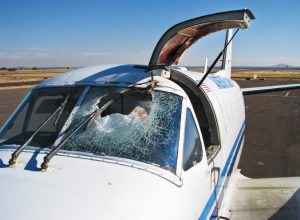I can’t put my finger on it but for some reason I feel today would be a great day to discuss bird strikes. A bird strike is a potentially serious safety of flight event and has the ability to cause substantial damage to an aircraft big or small. There have been over 142,000 reported bird strikes since 1990 but none more famous and well known then U.S. Airways Flight 1549’s crash into the Hudson River.
The most serious type of strike occurs when birds are ingested into the engine(s) which is ultimately what caused the crash of Flight 1549. Another common and very dangerous strike is to the windshield, this may often lead to pilot confusion and/or disorientation. Bird strikes to the fuselage, wings, or empennage along with any other part of the aircraft could cause aircraft control problems. This is not to say every bird strike will turn into an emergency but they should be taken serious and an abundance of caution exercised.
If you are unfortunate enough to sustain a bird strike pilots are encouraged to report such strikes using FAA Form 5200-7 which can be found here http://wildlife-mitigation.tc.faa.gov. It is also a good idea to report any observed bird activity on or near runways to the nearest control tower or air traffic control center. Follow this guideline for reporting:
- Geographic location
- Bird type (geese, ducks, gulls, etc.)
- Approximate number
- Altitude
- Direction of bird flight path

Reducing the risks of bird strikes involves remaining vigilant in or around airports, during phases of flight at low altitudes (takeoff or landing), or flying in the vicinity of wildlife refuges. The AIM recommends climbing to avoid collision as birds in flocks will often distribute themselves downwards. Also be sure to check the Airport Facility Directory (A/FD) for information on birds and other wildlife hazards at airports you intend to operate at. NOTAMs may also be issued for bird activity or advisories given over ATIS. When operating in areas with a high concentration of birds have a plan in place and review your emergency procedures, it’s always better to be safe than sorry.
2015 Wildlife Management and Strike Reporting update video from the FAA.
http://www.faa.gov/tv/?mediaId=1110
For additional information and a FAQ on bird strikes check out the FAA Wildlife Hazard Mitigation page: http://www.faa.gov/airports/airport_safety/wildlife/faq/




